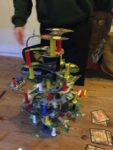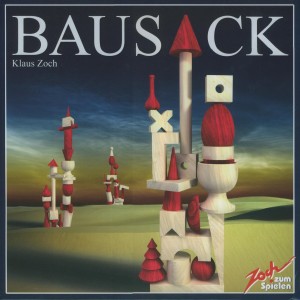- Learning time
- 10 minutes
- First play time
- 60 minutes
Menara
Designed by: Oliver Richtberg
In Menara all players work together to construct a temple from floors and pillars – how high it has to be depends on what difficulty level you play on, but as we’ll see, the requirements may change during the game…
Everyone starts with a certain number of coloured pillars (black, white, blue, red, yellow) drawn randomly from a bag, and there are six more in a shared ‘campsite’ with which you can swap pillars at the start of your turn.
The Temple starts with three randomly-selected floors laid adjacent on the table. On your go, you’ll flip over a card from one of three piles: easy, medium or difficult. The card will usually tell you how many pillars you can add to the temple, varying between one and four (there are a few special cards we’ll cover shortly). Having revealed the card, you now add pillars on matching-coloured spots on any temple level of your choice. Whenever the final level spot has a pillar on it, you must pause the game and add another temple level to the construction – it must go on pillars alone, and not overlap with any other levels.
If you cannot place the new level without collapsing the temple, you can add it to the base instead, to expand the building site – But! any time you do this, it adds another level to your winning objective. For instance on the easy setting, you only need to build three levels to win when the game begins. But failing to add a level when required (and indeed failing to add all the pillars a card demands because you don’t have the required pillars) pushes the winning requirement up to four.
Mixed into the pillar cards are some special cards that either demand you immediately fill a level of your choosing with pillars, or move a certain number of pillars upwards in the construction.
The result is an ongoing tactical, dexterity-based battle that is not as straightforward as simply flipping cards, but encourages communication and forward-planning. The players win by having built the desired amount of levels when either the levels, cards, or pillars run out. They lose by either not building high enough at that point, or by having the temple collapse!
Joe says
I'm not a huge fan of balancing games - I only own Junk Art and that's enough for me. The cooperative element here helps differentiate it from others of the genre, but overall it didn't really appeal.
The guru's verdict
-
Take That!
Take That!
None from the other players, except the possibility of finger-pointing when the temple collapses!
-
Fidget Factor!
Fidget Factor!
It all moves fast.
-
Brain Burn!
Brain Burn!
The rules are simple, but the game isn't: you don't want to take all the 'easy' cards because ending the game with just difficult ones is an almost-guaranteed disaster. But taking the difficult cards is always a risk... and a couple of plays will show that it really is a game where planning ahead can make the difference.
-
Again Again!
Again Again!
We've played this a lot. It can feel harsh when the temple collapses, but then it's so easy to set up and go again - the temple shapes are a real mixed bag and you end up with some crazy shaped constructions.













Sam says
Menara's rulebook comes with a story of discoveries and cursed temples but really, this is an abstract dexterity game with no theme. But as dexterity games go, it's an excellent one: a quest where the threat of more levels is as present as the threat of collapse. I really enjoy this one and we find ourselves playing it again and again.